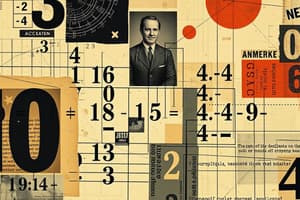Podcast
Questions and Answers
Which of the following is classified as a rational number?
Which of the following is classified as a rational number?
- √2
- π
- √3
- 1/2 (correct)
What is the result of the expression 5(3 + 2) - 4?
What is the result of the expression 5(3 + 2) - 4?
- 15
- 25
- 30
- 21 (correct)
Which type of angle is formed by two rays extending in opposite directions?
Which type of angle is formed by two rays extending in opposite directions?
- Acute Angle
- Obtuse Angle
- Straight Angle (correct)
- Reflex Angle
If the function f(x) = 3x + 4, what is f(2)?
If the function f(x) = 3x + 4, what is f(2)?
What does the standard deviation measure in a dataset?
What does the standard deviation measure in a dataset?
In trigonometry, which ratio is defined as opposite side over hypotenuse?
In trigonometry, which ratio is defined as opposite side over hypotenuse?
Which of the following best describes the concept of differentiation in calculus?
Which of the following best describes the concept of differentiation in calculus?
Which set of numbers includes only whole numbers?
Which set of numbers includes only whole numbers?
What is the formula for probability of an event occurring?
What is the formula for probability of an event occurring?
According to the Pythagorean Theorem, how do you relate the sides of a right triangle?
According to the Pythagorean Theorem, how do you relate the sides of a right triangle?
Flashcards are hidden until you start studying
Study Notes
Key Concepts in Mathematics
1. Number Systems
- Natural Numbers (N): Positive integers (1, 2, 3, ...)
- Whole Numbers (W): Natural numbers plus zero (0, 1, 2, 3, ...)
- Integers (Z): Whole numbers and their negatives (..., -3, -2, -1, 0, 1, 2, 3, ...)
- Rational Numbers (Q): Numbers that can be expressed as a fraction (a/b where a and b are integers, b ≠ 0).
- Irrational Numbers: Numbers that cannot be expressed as a fraction (e.g., √2, π).
- Real Numbers (R): All rational and irrational numbers.
2. Basic Operations
- Addition (+): Combining two numbers to get a sum.
- Subtraction (−): Finding the difference between two numbers.
- Multiplication (×): Repeated addition of a number.
- Division (÷): Splitting a number into equal parts.
3. Algebra
- Variables: Symbols that represent unknown values (commonly x, y).
- Expressions: Combinations of numbers, variables, and operations (e.g., 3x + 5).
- Equations: Mathematical statements asserting equality (e.g., 2x + 3 = 7).
- Functions: Relations that assign exactly one output for each input (e.g., f(x) = x^2).
4. Geometry
- Points: Exact locations in space.
- Lines: Straight paths extending infinitely in both directions.
- Angles: Formed by two rays with a common endpoint; measured in degrees.
- Shapes:
- 2D: Circles, triangles, squares, rectangles.
- 3D: Cubes, spheres, cylinders, cones.
5. Trigonometry
- Definitions: Study of relationships between angles and sides of triangles.
- Key Ratios:
- Sine (sin)
- Cosine (cos)
- Tangent (tan)
- Pythagorean Theorem: a² + b² = c² for right triangles.
6. Calculus
- Differentiation: Finding the rate of change of a function.
- Integration: Finding the area under a curve.
- Limits: The value that a function approaches as the input approaches a point.
7. Statistics
- Mean: Average of a set of numbers.
- Median: Middle value when numbers are arranged in order.
- Mode: Most frequently occurring value in a dataset.
- Standard Deviation: Measure of the amount of variation or dispersion in a set of values.
8. Probability
- Definition: Measure of the likelihood of an event to occur.
- Formula: Probability (P) = Number of favorable outcomes / Total number of outcomes.
- Independent Events: Two events where the outcome of one does not affect the other.
9. Mathematical Properties
- Commutative Property: a + b = b + a; a × b = b × a.
- Associative Property: (a + b) + c = a + (b + c); (a × b) × c = a × (b × c).
- Distributive Property: a(b + c) = ab + ac.
These concepts form the foundation of mathematics and are applicable in various fields including science, engineering, economics, and everyday problem-solving.
Number Systems
- Natural Numbers (N): The basic counting numbers starting from 1.
- Whole Numbers (W): Includes all natural numbers along with zero, beginning from 0.
- Integers (Z): Consists of whole numbers and their negative counterparts, representing a complete set of positive and negative numbers, including zero.
- Rational Numbers (Q): Any number that can be expressed as a fraction where both the numerator and denominator are integers, and the denominator is not zero.
- Irrational Numbers: Numbers that cannot be represented as fractions; examples include the square root of non-square integers and π.
- Real Numbers (R): The complete set that includes both rational and irrational numbers, covering all possible values on the number line.
Basic Operations
- Addition (+): The process of calculating the total of two or more values.
- Subtraction (−): Determines the difference between two amounts, indicating how much one number exceeds another.
- Multiplication (×): A mathematical operation involving repeated addition of a number, often represented as scaling.
- Division (÷): Splits a number into equal parts, determining how many times one number is contained within another.
Algebra
- Variables: Symbols such as x and y representing unknown quantities, essential for forming equations and expressions.
- Expressions: Combinations of numbers and variables that are intertwined with mathematical operations, e.g., 3x + 5.
- Equations: Assertions that two expressions are equal, exemplified by equations like 2x + 3 = 7.
- Functions: Relations that assign a single output for every input from a given set, illustrated by f(x) = x².
Geometry
- Points: Represent precise locations with no dimensions in space.
- Lines: Straight geometrical figures that extend infinitely in both directions with no curvature.
- Angles: Formed by two intersecting rays, measured in degrees which indicate the magnitude of rotation.
- Shapes:
- 2D Shapes: Include flat figures like circles, triangles, squares, and rectangles.
- 3D Shapes: Solid figures such as cubes, spheres, cylinders, and cones.
Trigonometry
- Study of the relationships that exist between the angles and sides of triangles, particularly right triangles.
- Key Ratios: Fundamental sine (sin), cosine (cos), and tangent (tan) ratios relate angles to side lengths.
- Pythagorean Theorem: A crucial formula for right triangles given as a² + b² = c², where c is the hypotenuse.
Calculus
- Differentiation: A method for calculating the rate at which a function changes, essential for understanding motion and trends.
- Integration: Used for determining the total accumulation of quantities, often visualized as finding areas under curves.
- Limits: Concept that defines the behavior of functions as inputs approach a particular point, foundational for calculus.
Statistics
- Mean: The average obtained by summing a set of numbers and dividing by the count of those numbers.
- Median: The middle value of a dataset when arranged in ascending order; effective at indicating central tendency.
- Mode: Represents the most frequently occurring number in a dataset, providing insight into common values.
- Standard Deviation: A statistical measure reflecting the degree of variation or dispersion from the mean in a set of values.
Probability
- Representation of the likelihood of a specific event occurring; core in statistics and forecasting.
- Probability (P): Measured with the formula P = Number of favorable outcomes / Total number of outcomes, aiding predictions.
- Independent Events: Two events where the occurrence of one does not influence the outcome of the other, crucial for probability calculations.
Mathematical Properties
- Commutative Property: Confirms equivalence in operation ordering for addition and multiplication; a + b = b + a and a × b = b × a.
- Associative Property: Indicates grouping of numbers does not affect the result for addition and multiplication; (a + b) + c = a + (b + c).
- Distributive Property: Shows the relationship between multiplication and addition, represented as a(b + c) = ab + ac, essential for simplifying expressions.
Studying That Suits You
Use AI to generate personalized quizzes and flashcards to suit your learning preferences.




